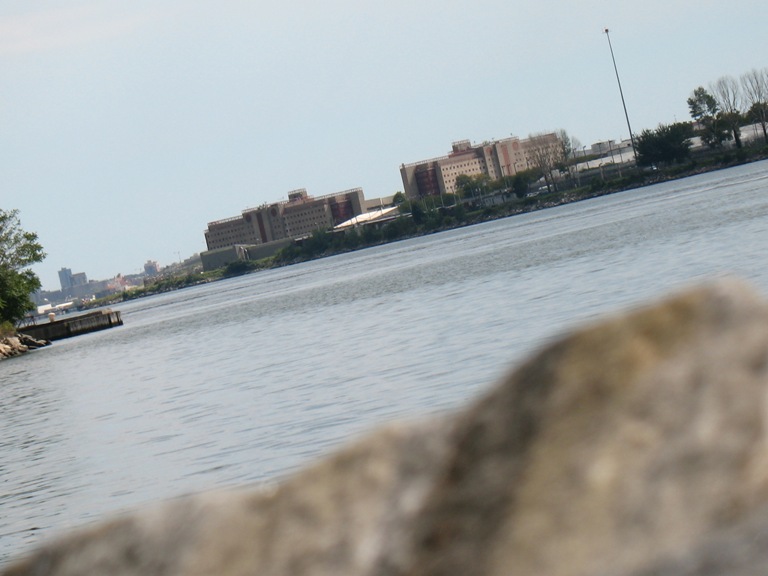“Every assessment and transfer deadline that passes without action delays the benefits of a transformed Rikers Island for all New Yorkers, especially those in the communities that have been directly harmed by unjust criminalization and environmental injustice.”

Jarrett Murphy
Rikers Island.Just last month, New York City was engulfed in smoke, carried south from raging wildfires in Canada. The daily average for fine particle pollution, known as PM2.5, was the highest since recording began in New York, leaving residents to battle dangerous air quality on the streets, in subway stations, and in their own homes. Since then, air quality alerts have become a recurring feature of the summer forecast.
This is one among many climate and environmental disasters that unfairly and disproportionately harm New York City’s environmental justice communities. Frontline communities are experiencing the effects of climate change every day, and the severity and frequency of climate disasters are predicted only to increase unless we act now to build an equitable, resilient, and sustainable future.
Renewable Rikers is a once-in-a-generation opportunity for New York City to advance its commitment to climate-resilient infrastructure, and to transition away from fossil fuels by elevating community priorities for renewable power systems and local, targeted workforce opportunities. The plan calls for a complete transformation of Rikers’ 413 acres by closing existing jail facilities and identifying sustainable, resilient uses for the island. A transformed Rikers Island could house the city’s largest solar array and energy storage equipment, facilities to turn our food waste into beneficial compost, and a modern wastewater treatment plant.
In fact, the New York City Department of Environmental Protection and the Mayor’s Office of Climate and Environmental Justice are already conducting feasibility studies for these projects, pursuant to Local Laws 17 and 31 of 2021, passed by City Council and signed into law by Mayor de Blasio as part of a Renewable Rikers legislative package.
New York State’s groundbreaking climate law–the Climate Leadership and Community Protection Act–sets bold statewide climate goals, including an 85 percent reduction in greenhouse gas emissions by 2050, with an interim target of 40 percent by 2030. The city has its own goals laid out in the 80 x 50 roadmap to reduce greenhouse gases 80 percent by 2050, the Climate Mobilization Act, and other policies. The Renewable Rikers vision presents a tremendous opportunity for New York City to achieve these state and local goals and advance our commitment to climate justice.
Crucially, the reimagining of Rikers Island could make it possible to decommission polluting and inefficient facilities like “peaker” power plants and wastewater treatment facilities that burden the same environmental justice communities most devastated by the jail complex’s history. It could also include a living-wage green jobs program, with formerly incarcerated individuals prioritized for training and hiring as part of a restorative justice strategy. Further, the properties that would be vacated by closing these noxious and aging facilities in other parts of the city could open the possibility for creative reuse of the land as envisioned by those directly impacted communities.
But to realize this vision of climate and environmental justice, Mayor Adams’ administration needs to lay the groundwork today. The city is required to shutter the jails and transfer all of Rikers Island away from the Department of Correction by Aug. 31, 2027, as mandated by Local Law 16 of 2021. To meet that deadline, the mayor must assess the current use of Rikers Island every six months, and transfer to the Department of Citywide Administrative Services those portions of the island not in active use for housing or providing direct services to people who are incarcerated.
While more than 10 percent of Rikers Island has been transferred to the Department of Citywide Administrative Services already, the last three assessment deadlines (July 1, 2022, January 1, 2023, and July 1, 2023) passed without any transfers taking place. One of the Rikers Island jails, the Otis Bantum Correctional Center, has sat empty through all three deadlines, with the Adams administration declining to transfer the facility because of its expectation that the jail population will increase.
This is not an outcome that a city committed to social and racial justice should be making room for, much less aiming toward. The Department of Correction largely detains people awaiting trial at the Rikers jail complex, many of whom are unable to afford the bail set in their case and would be at liberty if they could. Over 90 percent of people in New York City jails are non-white, and Black New Yorkers are admitted at 11 times the rate of white New Yorkers. Since Mayor Adams took office, 23 people have died in Department of Correction custody, and people detained at Rikers are also impacted by environmental risks like methane exposure, mold, contaminated water, vermin infestations, and extreme heat.
Every assessment and transfer deadline that passes without action delays the benefits of a transformed Rikers Island for all New Yorkers, especially those in the communities that have been directly harmed by unjust criminalization and environmental injustice.
Shravanthi Kanekal is a resiliency planner at the New York City Environmental Justice Alliance. Sara Imperiale is a senior attorney at the Natural Resources Defense Council.








